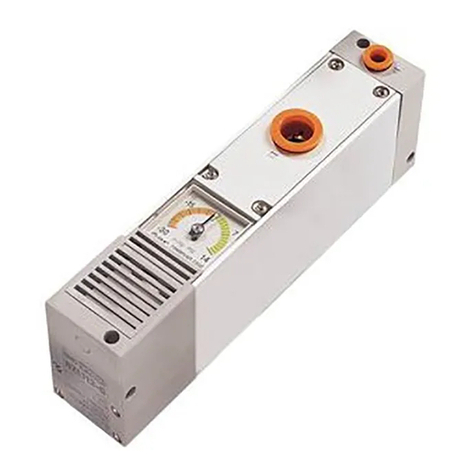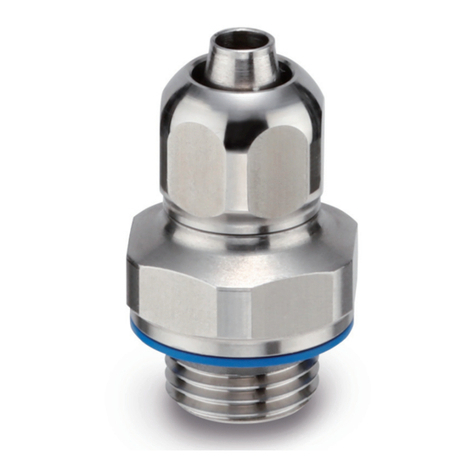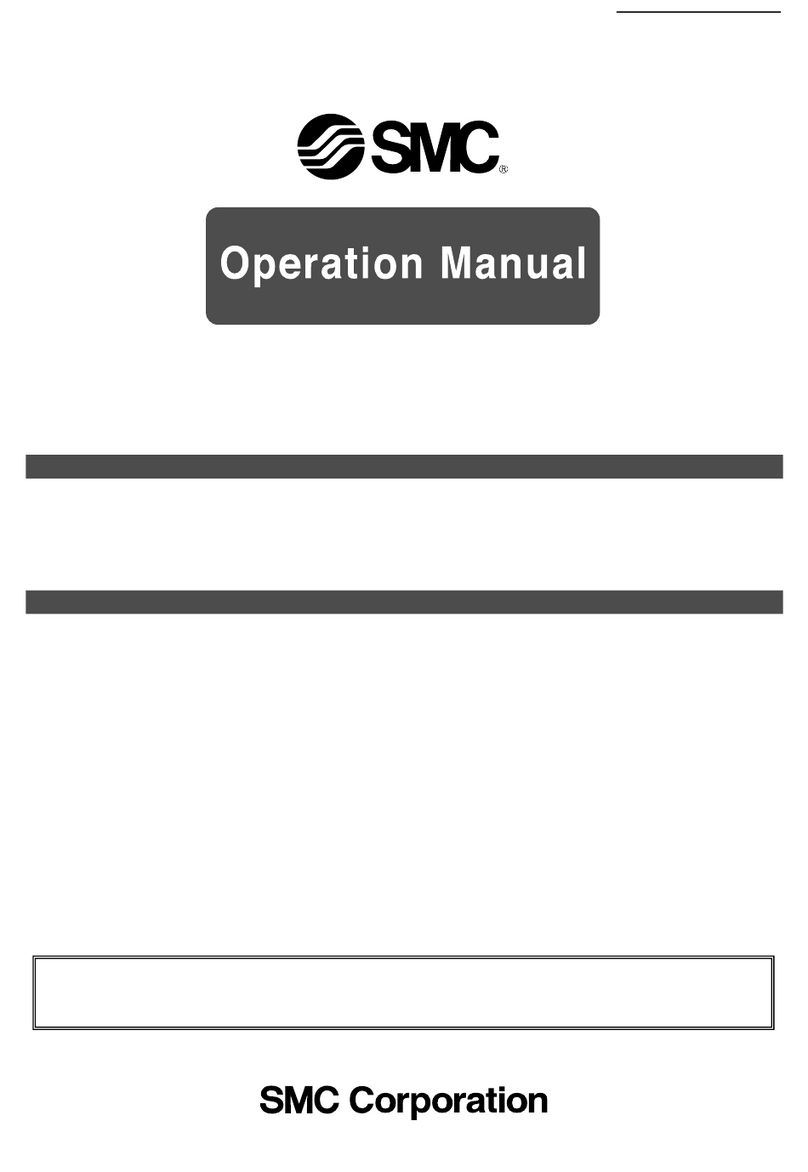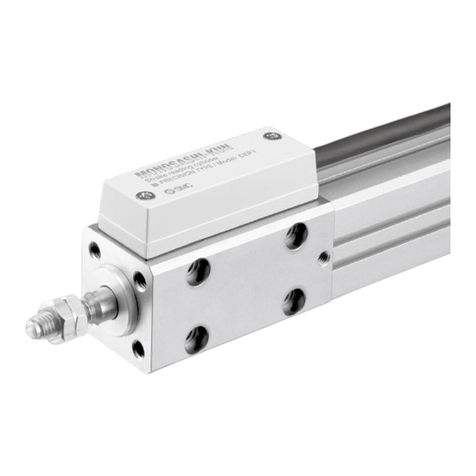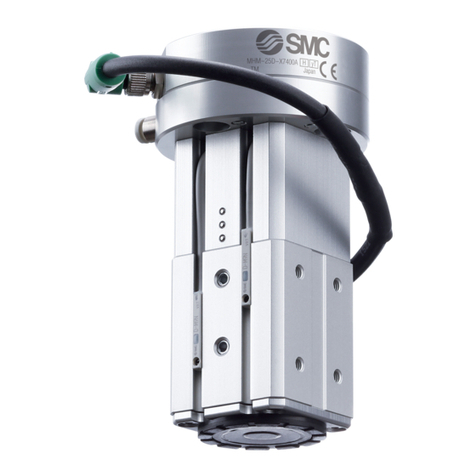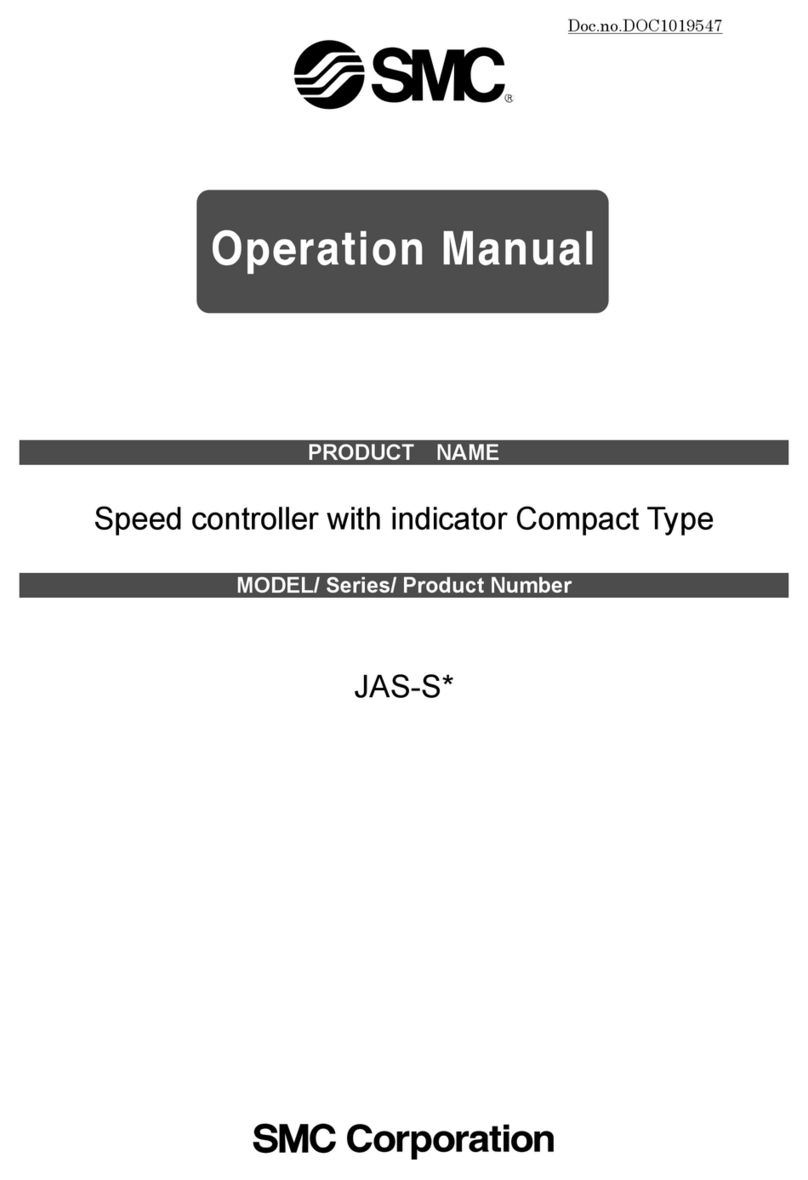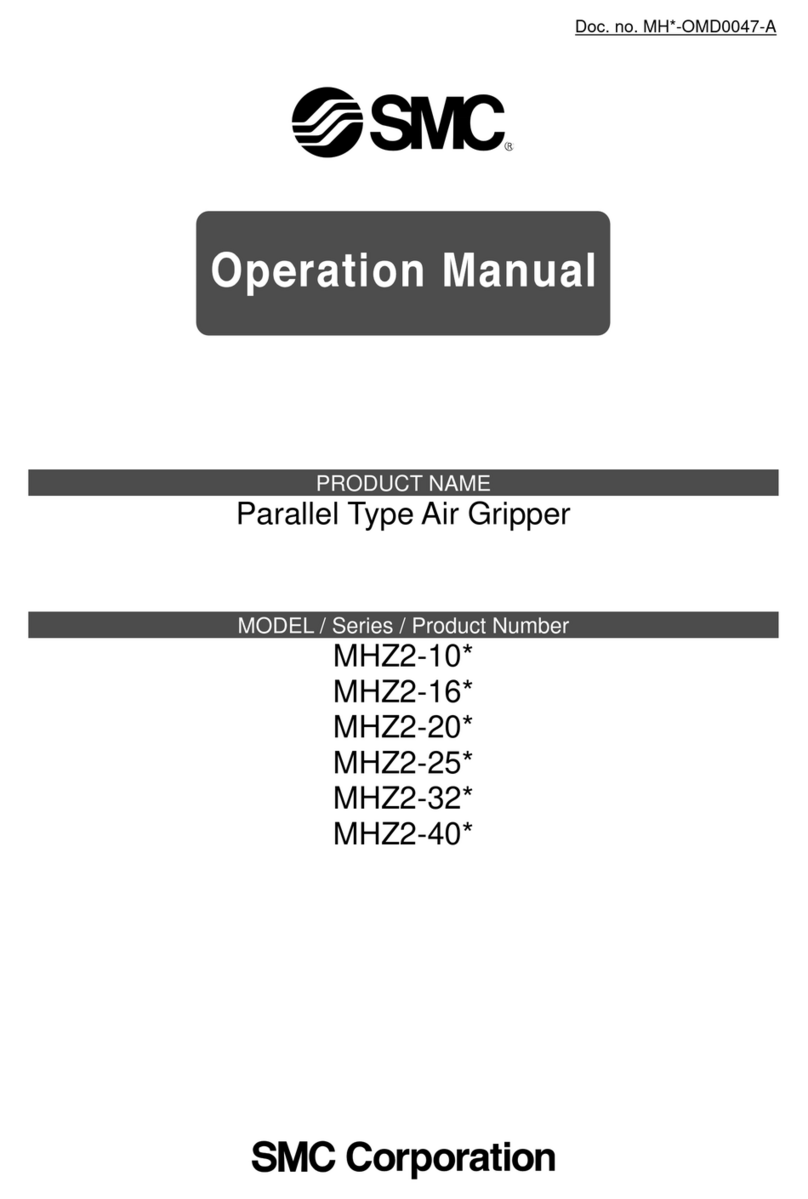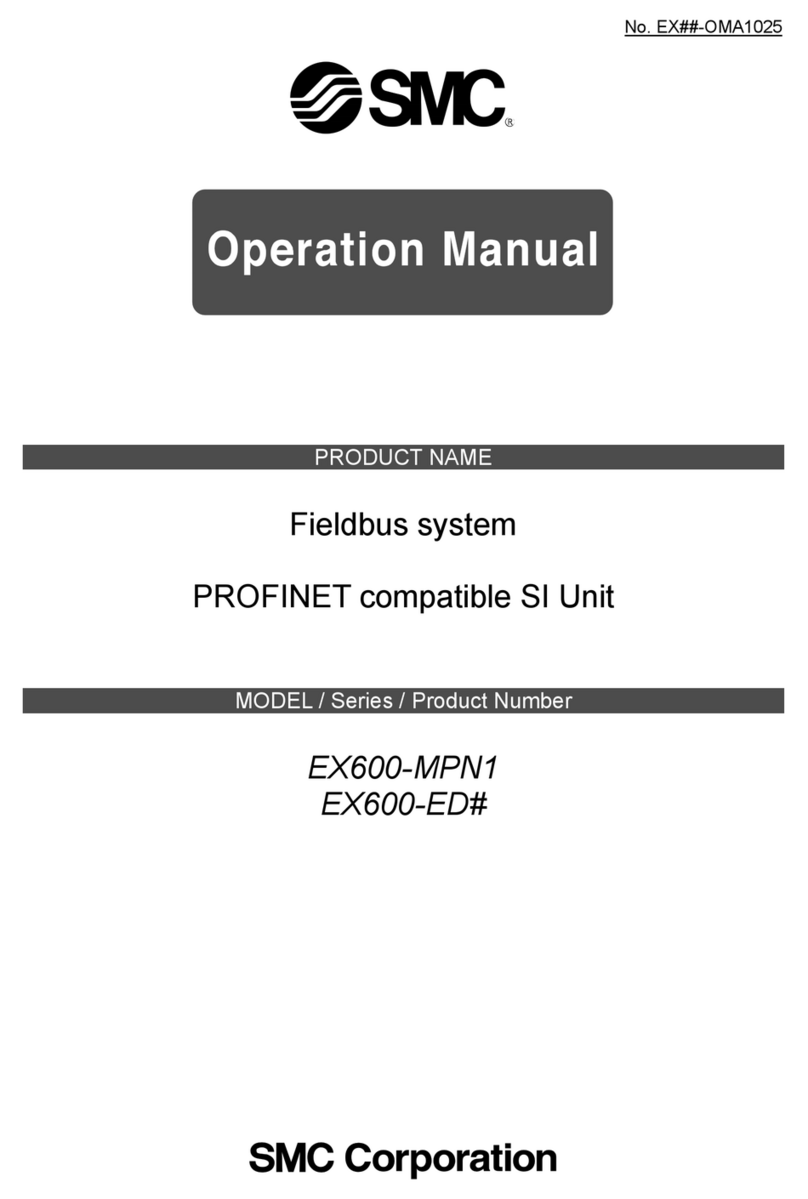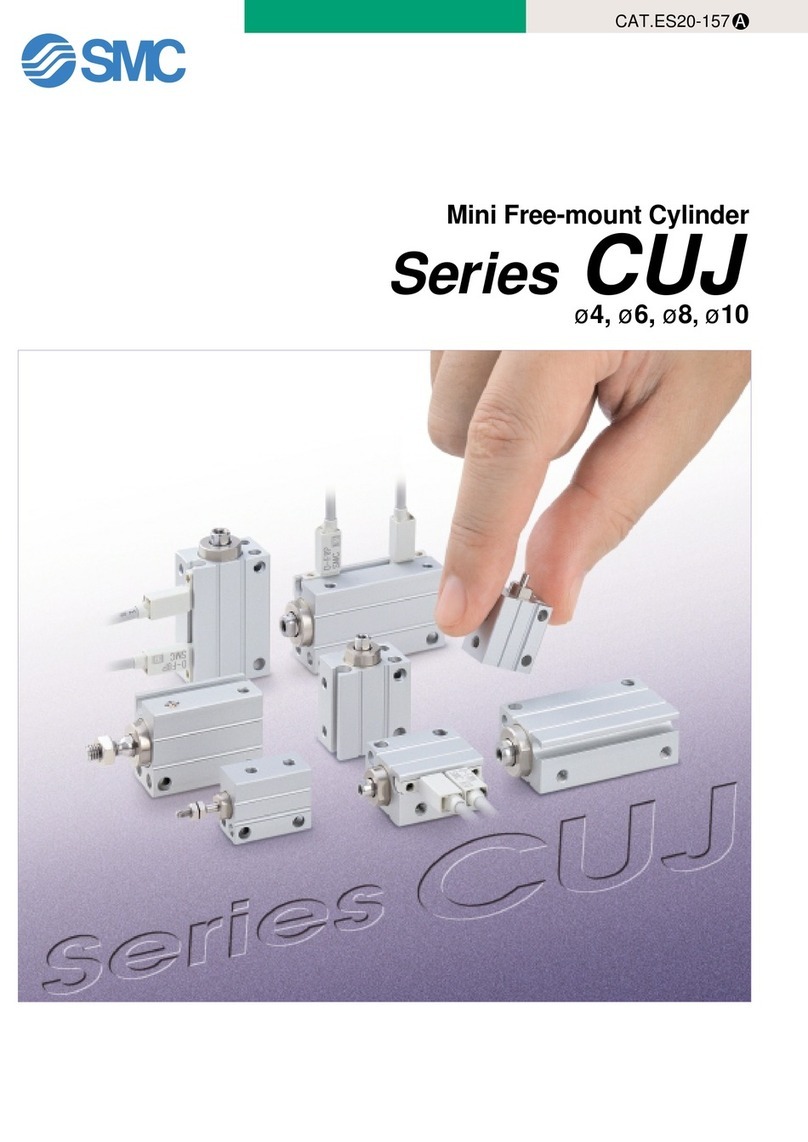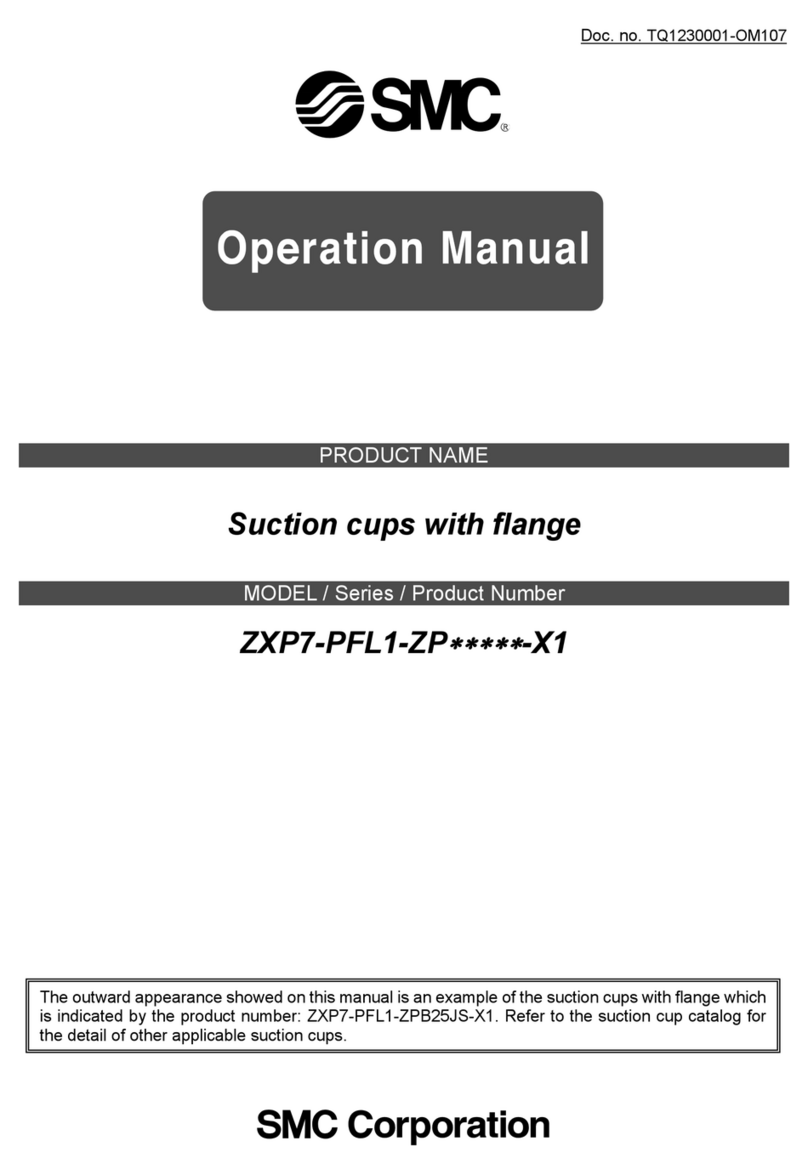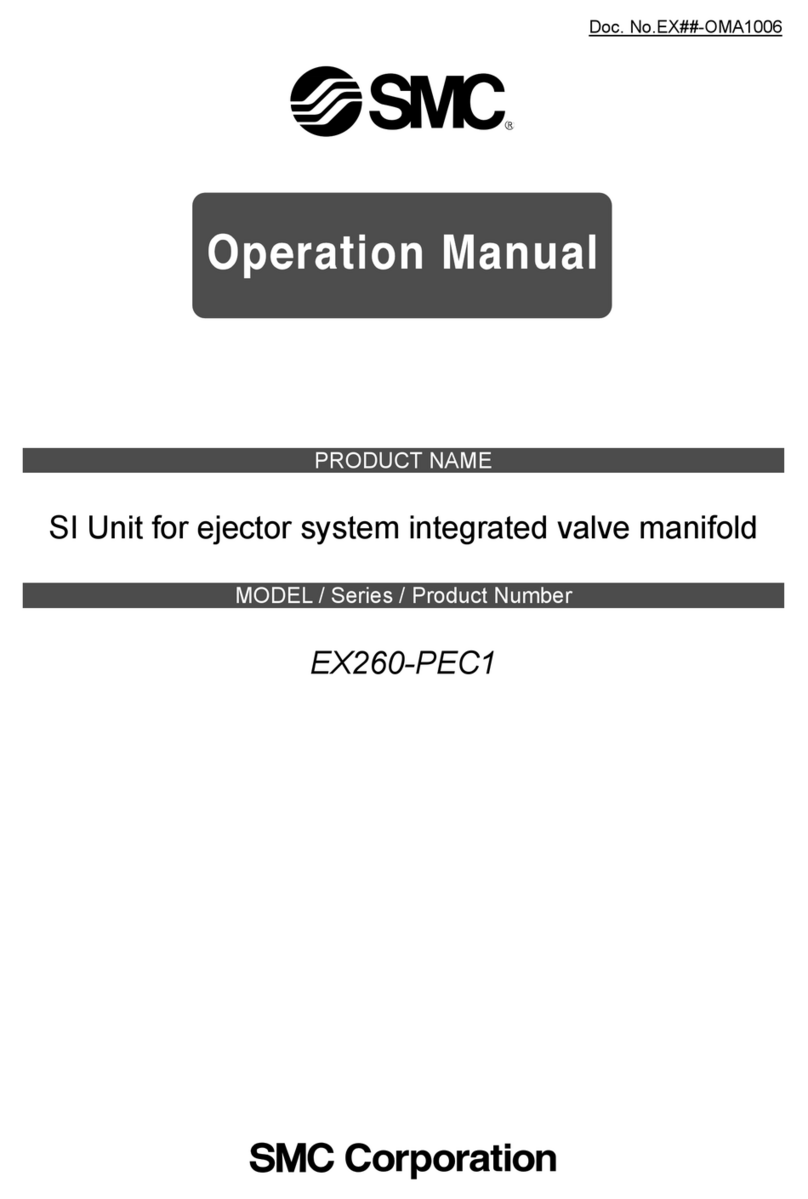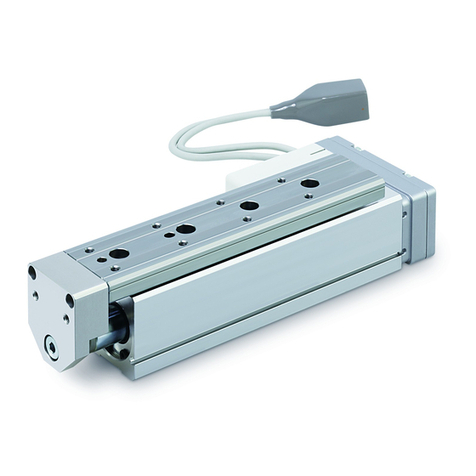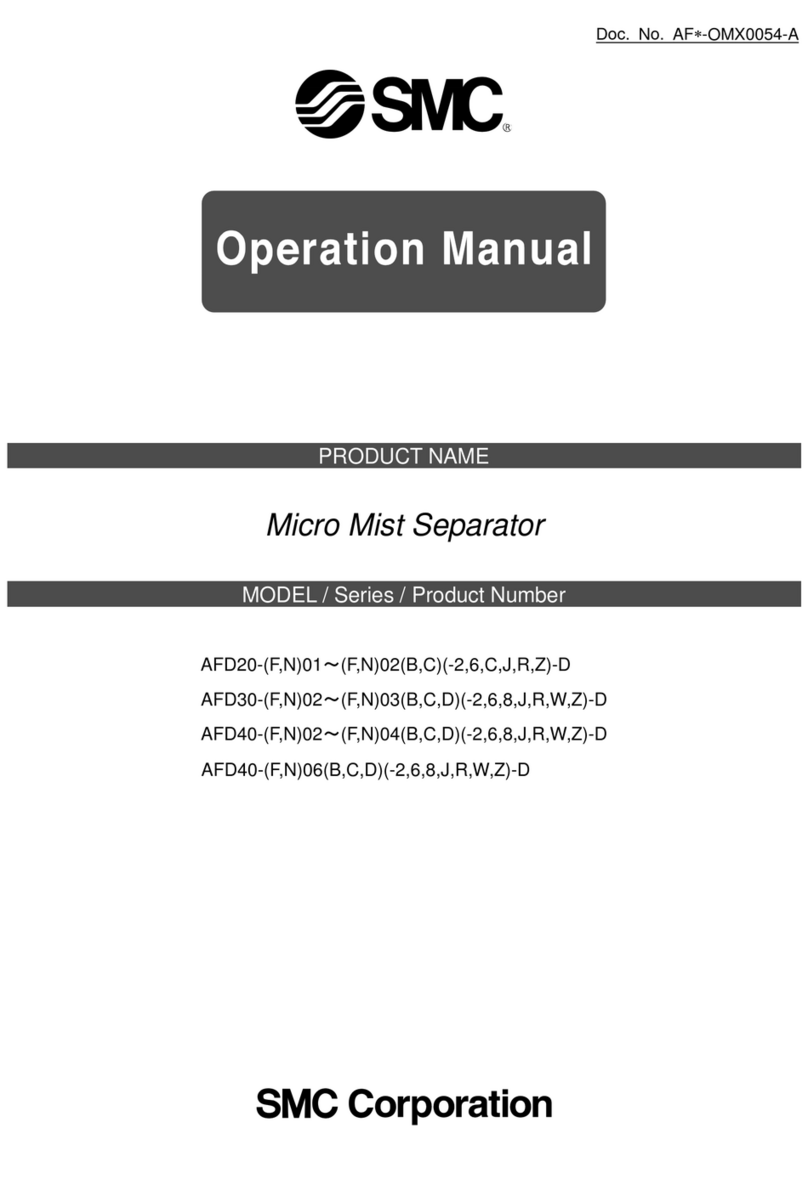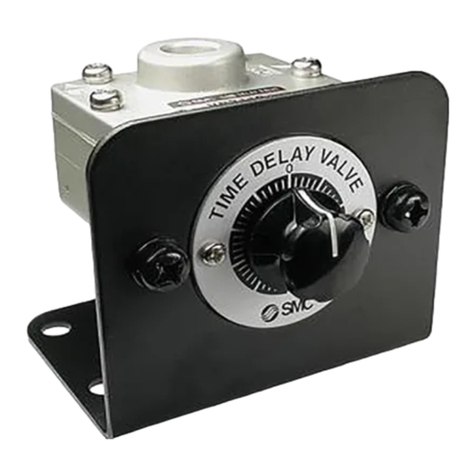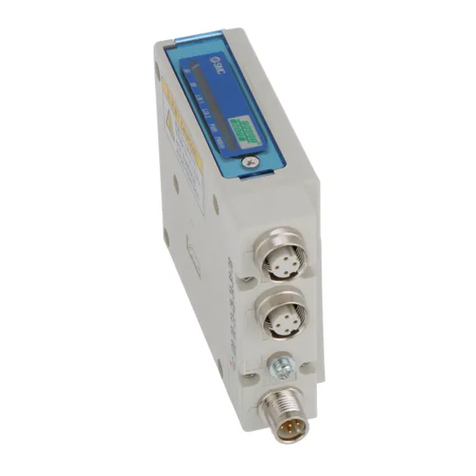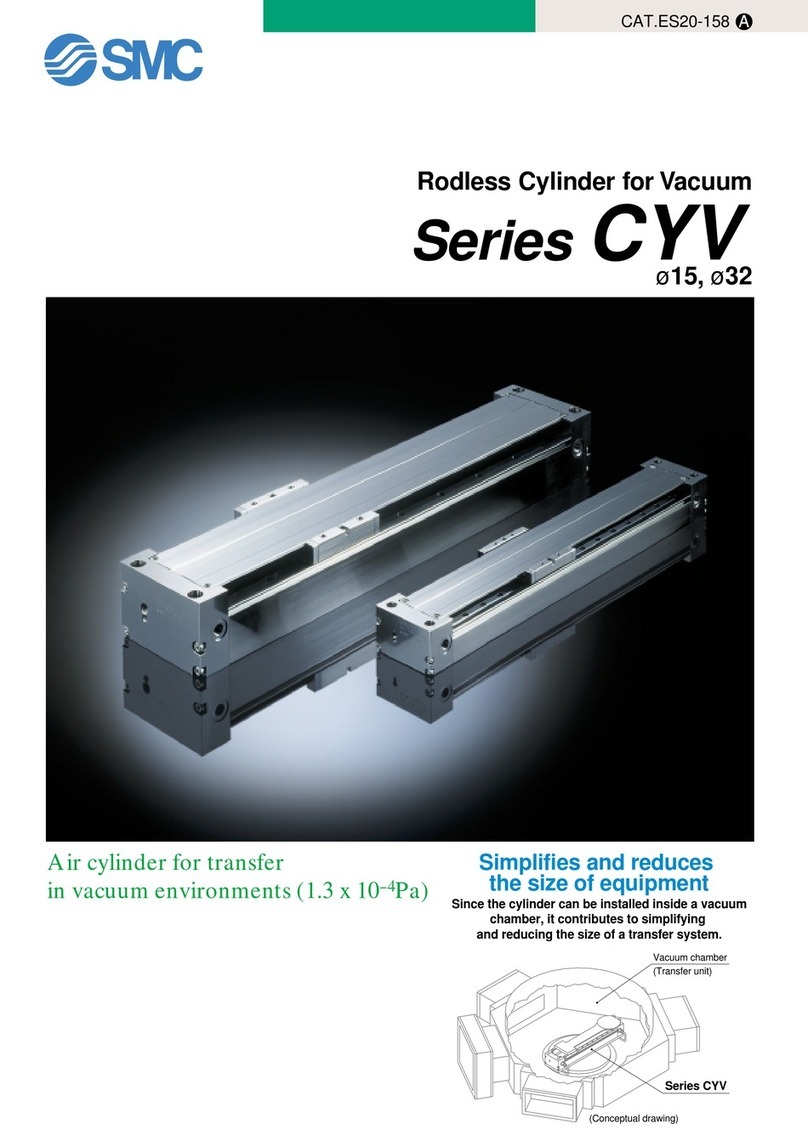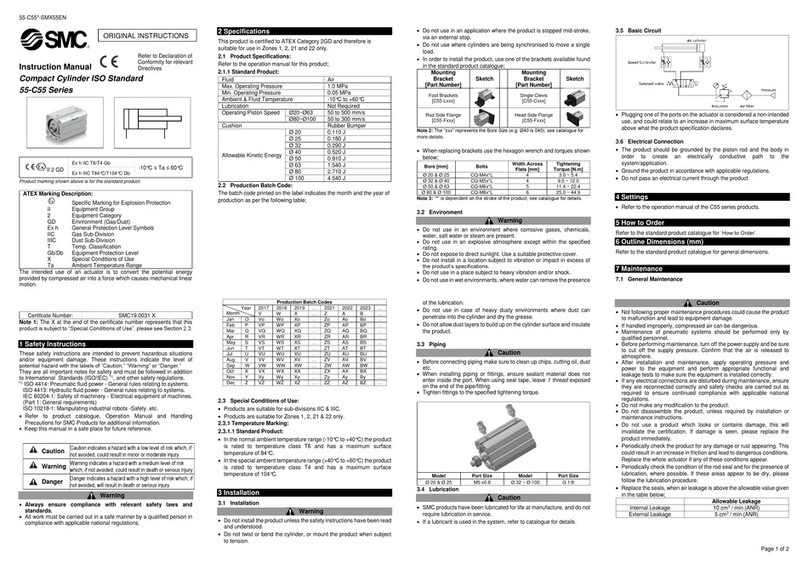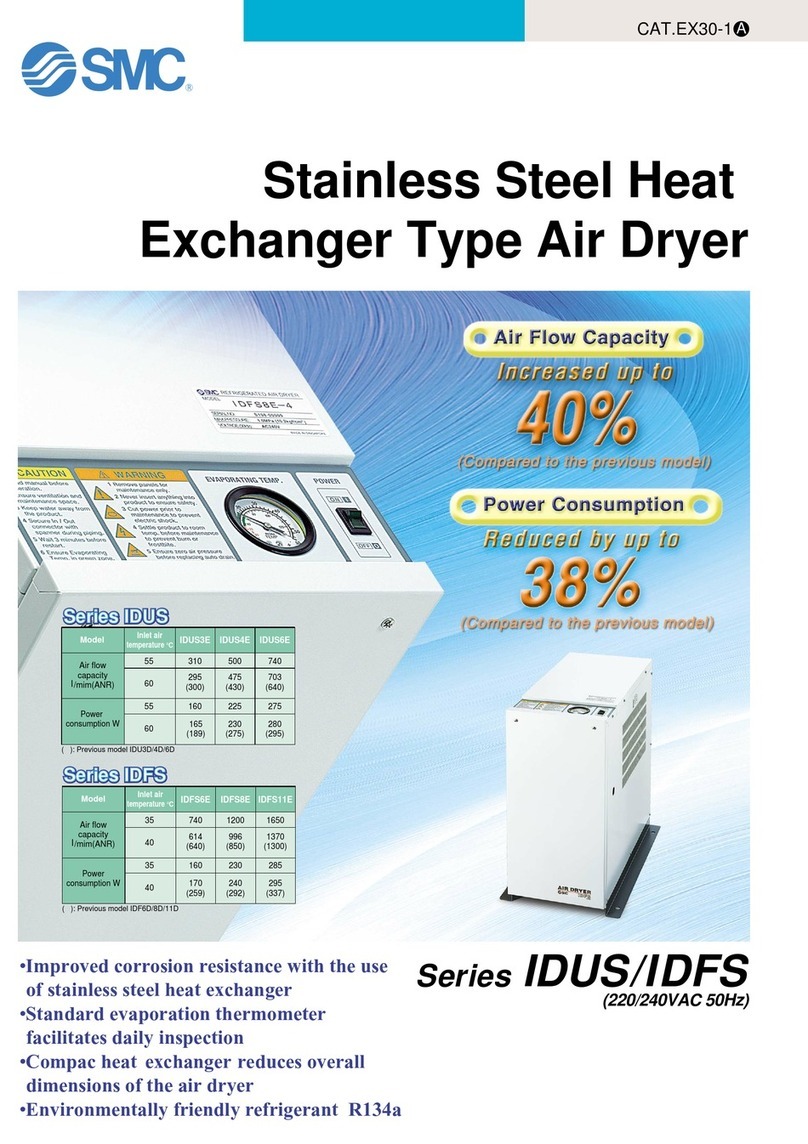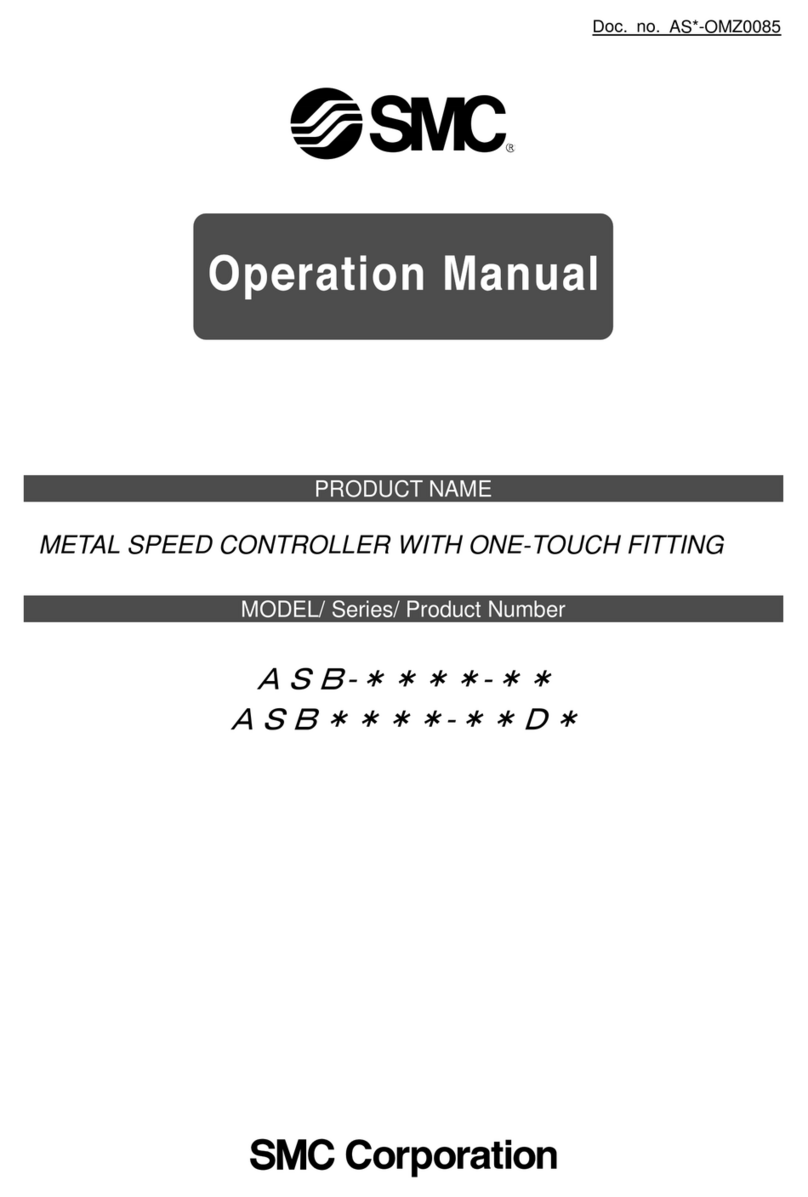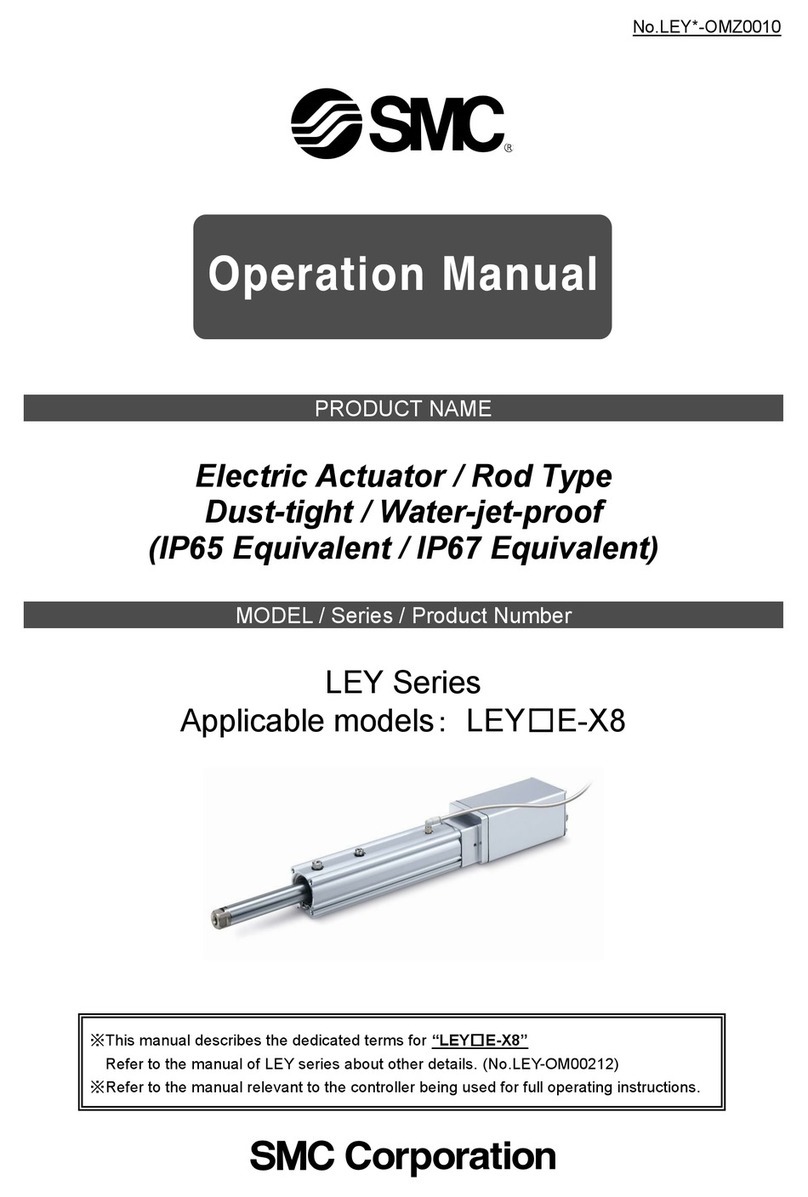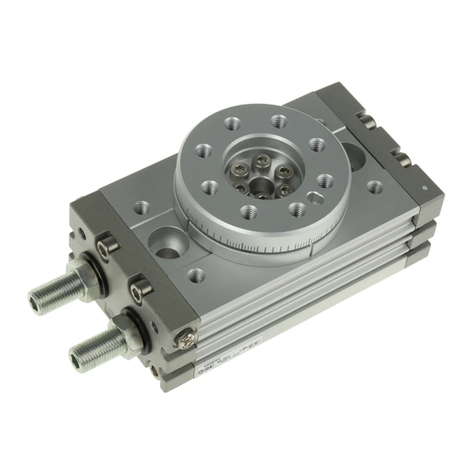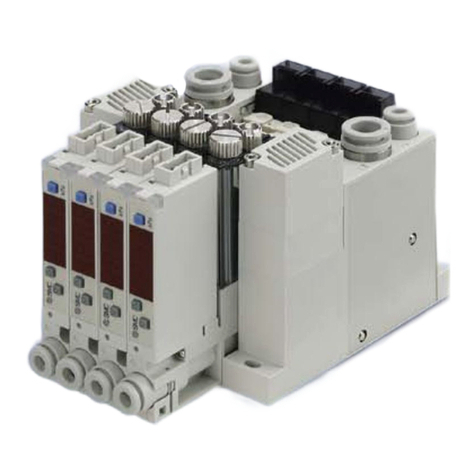
ZL3-
Serie
The intended use of this product is
1
These safety instructions are intended to prevent hazardous situ
potential hazard with the labels of “Caution,” “Warning” or “Danger.”
They are all important notes for safety and must be followed in addition
to International Standards (ISO/IEC)
*1)
ISO 4414: Pneumatic fluid power
ISO 4413: Hydraulic fluid power
IEC
(Part 1: General requirements)
•
Refer to product catalogue
Precautions for SMC Products for additional information.
•
Keep this manual in a safe place for future reference.
•
Always ensure compliance with relevant safety laws and
•
compliance with applicable national regulations.
X189EN
3/ZL6
The intended use of this product is
These safety instructions are intended to prevent hazardous situ
potential hazard with the labels of “Caution,” “Warning” or “Danger.”
They are all important notes for safety and must be followed in addition
to International Standards (ISO/IEC)
ISO 4414: Pneumatic fluid power
ISO 4413: Hydraulic fluid power
-
(Part 1: General requirements)
-
1: Manipulating industrial robots
Refer to product catalogue
Precautions for SMC Products for additional information.
Keep this manual in a safe place for future reference.
Caution
Caution indicates a hazard with a low level of risk which, if
not avoided, could result in minor or moderate injury.
Warning
Warning indicates a hazard with a medium level of risk
which, if not avoided, could result in death or serious injury.
Danger
Danger indicates a hazard with a high level of risk which, if
not avoided, will result in death or serious injury.
Always ensure compliance with relevant safety laws and
carried out in a safe manner by a qualified person in
compliance with applicable national regulations.
The intended use of this product is
These safety instructions are intended to prevent hazardous situ
These instructions indicate the level of
potential hazard with the labels of “Caution,” “Warning” or “Danger.”
They are all important notes for safety and must be followed in addition
to International Standards (ISO/IEC)
ISO 4414: Pneumatic fluid power
-
General rules relating to systems.
ISO 4413: Hydraulic fluid power
-
General rules relating to systems.
-
(Part 1: General requirements)
1: Manipulating industrial robots
Refer to product catalogue
, Operation Manual and Handling
Precautions for SMC Products for additional information.
Keep this manual in a safe place for future reference.
Caution indicates a hazard with a low level of risk which, if
not avoided, could result in minor or moderate injury.
Warning indicates a hazard with a medium level of risk
which, if not avoided, could result in death or serious injury.
Danger indicates a hazard with a high level of risk which, if
not avoided, will result in death or serious injury.
Always ensure compliance with relevant safety laws and
carried out in a safe manner by a qualified person in
compliance with applicable national regulations.
These safety instructions are intended to prevent hazardous situ
These instructions indicate the level of
potential hazard with the labels of “Caution,” “Warning” or “Danger.”
They are all important notes for safety and must be followed in addition
, and other safety regulations.
General rules relating to systems.
General rules relating to systems.
Electrical equipment of machines.
1: Manipulating industrial robots
-
, Operation Manual and Handling
Precautions for SMC Products for additional information.
Keep this manual in a safe place for future reference.
Caution indicates a hazard with a low level of risk which, if
not avoided, could result in minor or moderate injury.
Warning indicates a hazard with a medium level of risk
which, if not avoided, could result in death or serious injury.
Danger indicates a hazard with a high level of risk which, if
not avoided, will result in death or serious injury.
Always ensure compliance with relevant safety laws and
carried out in a safe manner by a qualified person in
compliance with applicable national regulations.
These safety instructions are intended to prevent hazardous situ
These instructions indicate the level of
potential hazard with the labels of “Caution,” “Warning” or “Danger.”
They are all important notes for safety and must be followed in addition
, and other safety regulations.
General rules relating to systems.
General rules relating to systems.
Electrical equipment of machines.
etc.
, Operation Manual and Handling
Precautions for SMC Products for additional information.
Keep this manual in a safe place for future reference.
Caution indicates a hazard with a low level of risk which, if
not avoided, could result in minor or moderate injury.
Warning indicates a hazard with a medium level of risk
which, if not avoided, could result in death or serious injury.
Danger indicates a hazard with a high level of risk which, if
not avoided, will result in death or serious injury.
Always ensure compliance with relevant safety laws and
carried out in a safe manner by a qualified person in
These instructions indicate the level of
They are all important notes for safety and must be followed in addition
, and other safety regulations.
General rules relating to systems.
General rules relating to systems.
Electrical equipment of machines.
, Operation Manual and Handling
Caution indicates a hazard with a low level of risk which, if
Warning indicates a hazard with a medium level of risk
which, if not avoided, could result in death or serious injury.
Danger indicates a hazard with a high level of risk which, if
Always ensure compliance with relevant safety laws and
carried out in a safe manner by a qualified person in
Refer to catalogue for more details.
Operating temperature range
Operating temperature range
measurement standards. They depend on atmospheric pressure (weather, altitude,
etc.) and measurement method.
Refer to catalogue for more details.
,
*
Operating temperature range
*
,
*
Operating temperature range
*
)
Values are at the same standard supply pressure and based on SMC’s
measurement standards. They depend on atmospheric pressure (weather, altitude,
etc.) and measurement method.
)
10 to 500Hz for 2 hours in each direction of X, Y and Z (de
)
3 times in each direction of X, Y and Z (de
*4)
Refer to operation manual of solenoid valve (
Do not install the product unless the saf
read
When m
ounting the product, tighten with the recommended
tightening torque of the following screws.
-
Top surface and side surface mounting: 0.56 to 0.76
-
Bottom mounting: 0.29 to 0.30
When
installing the product, secure the space required for
maintenance and inspection of the product
Do not drop
, hit, or apply excessive impact to the product.
Do not use in an environment where corrosive gases, chemicals, salt
water or steam are present.
Do not use in an explosive atmosphere.
Do not expose to direct sunlight. Use a suitable protective cover.
Do not
install in a location subject to vibration or i
the product’s specifications
Do not mount in a location exposed to radiant heat
in temperatures in excess of the product’s specifications
the u
sage environment of the product, consider using a vacuum filter
(AFJ series)
Do not use in place where static electricity build up can occur.
Do not use in an environment where surges occur
Refer to catalogue for more details.
*
*
Operating temperature range
*
*
*
Operating temperature range
*
Values are at the same standard supply pressure and based on SMC’s
measurement standards. They depend on atmospheric pressure (weather, altitude,
etc.) and measurement method.
10 to 500Hz for 2 hours in each direction of X, Y and Z (de
3 times in each direction of X, Y and Z (de
Refer to operation manual of solenoid valve (
10
series) for the characteristics.
Do not install the product unless the saf
.
ounting the product, tighten with the recommended
tightening torque of the following screws.
Top surface and side surface mounting: 0.56 to 0.76
Bottom mounting: 0.29 to 0.30
installing the product, secure the space required for
maintenance and inspection of the product
, hit, or apply excessive impact to the product.
Do not use in an environment where corrosive gases, chemicals, salt
water or steam are present.
Do not use in an explosive atmosphere.
Do not expose to direct sunlight. Use a suitable protective cover.
install in a location subject to vibration or i
the product’s specifications
.
Do not mount in a location exposed to radiant heat
in temperatures in excess of the product’s specifications
sage environment of the product, consider using a vacuum filter
Do not use in place where static electricity build up can occur.
Do not use in an environment where surges occur
Refer to catalogue for more details.
ZL3M□□
1.9
0.35 MPa
-91 kPa
L/min (ANR)
5 to 50
o
C (No
ZL6M□□
1.9 x 2
0.35 MPa
0.37 MPa
-91 kPa
L/min (ANR)
5 to 50
o
C (No
Values are at the same standard supply pressure and based on SMC’s
measurement standards. They depend on atmospheric pressure (weather, altitude,
10 to 500Hz for 2 hours in each direction of X, Y and Z (de
3 times in each direction of X, Y and Z (de
Refer to operation manual of solenoid valve (
series) for the characteristics.
Warning
Do not install the product unless the saf
ety instructions have been
ounting the product, tighten with the recommended
tightening torque of the following screws.
Top surface and side surface mounting: 0.56 to 0.76
Bottom mounting: 0.29 to 0.30
N•m
installing the product, secure the space required for
maintenance and inspection of the product
, hit, or apply excessive impact to the product.
Warning
Do not use in an environment where corrosive gases, chemicals, salt
Do not use in an explosive atmosphere.
Do not expose to direct sunlight. Use a suitable protective cover.
install in a location subject to vibration or i
Do not mount in a location exposed to radiant heat
in temperatures in excess of the product’s specifications
-
in suction filter. If there is dust in
sage environment of the product, consider using a vacuum filter
Do not use in place where static electricity build up can occur.
Do not use in an environment where surges occur
ZL3H
0.50
-
135
6 MPa
Air
2
2
ZL6H
1.5 x
0.50
0.52
-
270
6 MPa
Air
2
2
Values are at the same standard supply pressure and based on SMC’s
measurement standards. They depend on atmospheric pressure (weather, altitude,
10 to 500Hz for 2 hours in each direction of X, Y and Z (de
energised, initial value)
Refer to operation manual of solenoid valve (
JSY3000
series) for the characteristics.
ety instructions have been
ounting the product, tighten with the recommended
Top surface and side surface mounting: 0.56 to 0.76
installing the product, secure the space required for
, hit, or apply excessive impact to the product.
Do not use in an environment where corrosive gases, chemicals, salt
Do not expose to direct sunlight. Use a suitable protective cover.
install in a location subject to vibration or i
mpact
Do not mount in a location exposed to radiant heat
in temperatures in excess of the product’s specifications
in suction filter. If there is dust in
sage environment of the product, consider using a vacuum filter
Do not use in place where static electricity build up can occur.
Do not use in an environment where surges occur
.
2
Values are at the same standard supply pressure and based on SMC’s
measurement standards. They depend on atmospheric pressure (weather, altitude,
10 to 500Hz for 2 hours in each direction of X, Y and Z (de
-energised,
energised, initial value)
series) and
ety instructions have been
ounting the product, tighten with the recommended
Top surface and side surface mounting: 0.56 to 0.76
N•m
installing the product, secure the space required for
Do not use in an environment where corrosive gases, chemicals, salt
Do not expose to direct sunlight. Use a suitable protective cover.
in suction filter. If there is dust in
sage environment of the product, consider using a vacuum filter
Do not use in place where static electricity build up can occur.
3
3.3
●
Do not use air containing chemicals, synthetic oils containing organic
solvents, salts, or corrosive gases.
●R
ecommended quality of the
compressed air cleanliness grade "2:
2010.
•
Do not supply the pressure
3.4
•
•
gets inside the port. When using sealing tape, wind it with one thread
left.
•
Tighten fittings to the specified tightening torque
•Fix
the side of the body when piping to the vacuum (2 / V) port and
piping to the exhaust (3 / E) port.
3.5
Refer to the operation manual of solenoid valve (
4
4.1
Manual Override (With supply valve and release valve)
Refer to the operation manual of the solenoid valve JSY
for the manual operation method.
4.2
When the release valve is turned on, vacuum break air is let out.
The release flow adjusting needle allows to control the vacuum break
To adjust the break air flow, pull the push
break flow, and turn the handle anti
5
Refer to
6
Refer to the catalogue for
-
Do not use air containing chemicals, synthetic oils containing organic
solvents, salts, or corrosive gases.
ecommended quality of the
compressed air cleanliness grade "2:
Do not supply the pressure
connecting
piping make sure to clean up chips, cutting
installing piping and fittings, make sure that no sealing material
gets inside the port. When using sealing tape, wind it with one thread
Tighten fittings to the specified tightening torque
(2/V) port
(3/E) port
the side of the body when piping to the vacuum (2 / V) port and
piping to the exhaust (3 / E) port.
to the solenoid valve and pressure switches
Refer to the operation manual of solenoid valve (
Manual Override (With supply valve and release valve)
Refer to the operation manual of the solenoid valve JSY
for the manual operation method.
When the release valve is turned on, vacuum break air is let out.
The release flow adjusting needle allows to control the vacuum break
To adjust the break air flow, pull the push
push-
locking handle clockwise to reduce the vacuum
break flow, and turn the handle anti
catalogue
Refer to the catalogue for
release
Body surface
(
Do not use air containing chemicals, synthetic oils containing organic
solvents, salts, or corrosive gases.
ecommended quality of the
supplied air be equivalent to the
compressed air cleanliness grade "2:
Do not supply the pressure
in excess of the product’s specifications
piping make sure to clean up chips, cutting
installing piping and fittings, make sure that no sealing material
gets inside the port. When using sealing tape, wind it with one thread
Tighten fittings to the specified tightening torque
Port size
1/2 or 3/4
1
1/8
the side of the body when piping to the vacuum (2 / V) port and
port and
fix the side of the port block when
piping to the exhaust (3 / E) port.
to the solenoid valve and pressure switches
Refer to the operation manual of solenoid valve (
series).
Manual Override (With supply valve and release valve)
Refer to the operation manual of the solenoid valve JSY
for the manual operation method.
needle
When the release valve is turned on, vacuum break air is let out.
The release flow adjusting needle allows to control the vacuum break
To adjust the break air flow, pull the push
locking handle clockwise to reduce the vacuum
break flow, and turn the handle anti
-
clockwise to increase the flow.
Refer to the catalogue for
)
Vacuum pressure detection(G) port
Do not use air containing chemicals, synthetic oils containing organic
supplied air be equivalent to the
in excess of the product’s specifications
piping make sure to clean up chips, cutting
installing piping and fittings, make sure that no sealing material
gets inside the port. When using sealing tape, wind it with one thread
Tighten fittings to the specified tightening torque
torque
the side of the body when piping to the vacuum (2 / V) port and
fix the side of the port block when
to the solenoid valve and pressure switches
Refer to the operation manual of solenoid valve (
J
Manual Override (With supply valve and release valve)
Refer to the operation manual of the solenoid valve JSY
When the release valve is turned on, vacuum break air is let out.
The release flow adjusting needle allows to control the vacuum break
To adjust the break air flow, pull the push
-
locking handle to unlock it.
locking handle clockwise to reduce the vacuum
clockwise to increase the flow.
.
.
Exhaust block surface to be held
Vacuum pressure detection(G) port
Do not use air containing chemicals, synthetic oils containing organic
supplied air be equivalent to the
-1:
in excess of the product’s specifications
piping make sure to clean up chips, cutting
installing piping and fittings, make sure that no sealing material
gets inside the port. When using sealing tape, wind it with one thread
to 30 N・m
to 38 N・m
to 5 N・m
the side of the body when piping to the vacuum (2 / V) port and
fix the side of the port block when
to the solenoid valve and pressure switches
3000
Manual Override (With supply valve and release valve)
Refer to the operation manual of the solenoid valve JSY
3000
When the release valve is turned on, vacuum break air is let out.
The release flow adjusting needle allows to control the vacuum break
locking handle to unlock it.
locking handle clockwise to reduce the vacuum
clockwise to increase the flow.
Exhaust block surface to be held
Vacuum pressure detection(G) port
Do not use air containing chemicals, synthetic oils containing organic
in excess of the product’s specifications
.
installing piping and fittings, make sure that no sealing material
gets inside the port. When using sealing tape, wind it with one thread
the side of the body when piping to the vacuum (2 / V) port and
fix the side of the port block when
The release flow adjusting needle allows to control the vacuum break
locking handle clockwise to reduce the vacuum
7
•
•
•
•
•
•
•
•
•
•
•
•
•
1) Loosen the two mounting screws of the silencer assembly and
2) Replace the sound absorbing material inside the silencer case (Fig.2)
3) Attach the silencer assembly using the mounting screws.
1) Align the hook of the silencer assembly with the groove of the body,
2) When removing, slide the silencer
Not following proper maintenance procedures could cause the
product to malfunction and lead to equipment damage.
If handled improperly, compressed air can be dangerous.
Maintenance of pneumatic systems should be per
Before performing maintenance,
sure to cut off the supply pressure. Confirm that the air is released to
atmosphere.
After installation and maintenance, apply operating pressure and
power
to the equipment and perform appropriate functional and
leakage tests to make sure the equipment is installed correctly.
If any electrical connections are disturbed during maintenance,
ensure they are reconnected
ou
t as required to ensure continued compliance with applicable
Do not make any modification to the product.
Do not disassemble the product, unless required by installation or
Implement the maintenance and check shown below to use the
multistage ejector safely and in an appropriate way for a long period
of time.
Drain
the air filter and mist separator regularly
Replace the sound absorbing material (silencer) built into the ejec
regularly
Refer to the online operation manual for replacement parts.
Do not use
benzene or thinner for cleaning.
Replacement method of sound absorbing material (ZL3)
1) Loosen the two mounting screws of the silencer assembly and
remove the sil
2) Replace the sound absorbing material inside the silencer case (Fig.2)
3) Attach the silencer assembly using the mounting screws.
S
1) Align the hook of the silencer assembly with the groove of the body,
break it, and push it in the direction of the arrow until it clicks.
2) When removing, slide the silencer
to the mounting direction to remove it.
Not following proper maintenance procedures could cause the
product to malfunction and lead to equipment damage.
If handled improperly, compressed air can be dangerous.
Maintenance of pneumatic systems should be per
Before performing maintenance,
sure to cut off the supply pressure. Confirm that the air is released to
After installation and maintenance, apply operating pressure and
to the equipment and perform appropriate functional and
leakage tests to make sure the equipment is installed correctly.
If any electrical connections are disturbed during maintenance,
ensure they are reconnected
t as required to ensure continued compliance with applicable
Do not make any modification to the product.
Do not disassemble the product, unless required by installation or
Implement the maintenance and check shown below to use the
multistage ejector safely and in an appropriate way for a long period
the air filter and mist separator regularly
Replace the sound absorbing material (silencer) built into the ejec
Refer to the online operation manual for replacement parts.
benzene or thinner for cleaning.
Replacement method of sound absorbing material (ZL3)
1) Loosen the two mounting screws of the silencer assembly and
2) Replace the sound absorbing material inside the silencer case (Fig.2)
3) Attach the silencer assembly using the mounting screws.
tightening torque: 0.76 to 0.84 Nm)
1) Align the hook of the silencer assembly with the groove of the body,
break it, and push it in the direction of the arrow until it clicks.
2) When removing, slide the silencer
to the mounting direction to remove it.
Caution
Not following proper maintenance procedures could cause the
product to malfunction and lead to equipment damage.
If handled improperly, compressed air can be dangerous.
Maintenance of pneumatic systems should be per
Before performing maintenance,
turn off the power supply and be
sure to cut off the supply pressure. Confirm that the air is released to
After installation and maintenance, apply operating pressure and
to the equipment and perform appropriate functional and
leakage tests to make sure the equipment is installed correctly.
If any electrical connections are disturbed during maintenance,
and safety checks are carried
t as required to ensure continued compliance with applicable
Do not make any modification to the product.
Do not disassemble the product, unless required by installation or
Implement the maintenance and check shown below to use the
multistage ejector safely and in an appropriate way for a long period
the air filter and mist separator regularly
Replace the sound absorbing material (silencer) built into the ejec
Refer to the online operation manual for replacement parts.
benzene or thinner for cleaning.
Replacement method of sound absorbing material (ZL3)
1) Loosen the two mounting screws of the silencer assembly and
2) Replace the sound absorbing material inside the silencer case (Fig.2)
3) Attach the silencer assembly using the mounting screws.
tightening torque: 0.76 to 0.84 Nm)
1) Align the hook of the silencer assembly with the groove of the body,
break it, and push it in the direction of the arrow until it clicks.
2) When removing, slide the silencer
assembly in the direction opposite
to the mounting direction to remove it.
Assembly
screws
Not following proper maintenance procedures could cause the
product to malfunction and lead to equipment damage.
If handled improperly, compressed air can be dangerous.
Maintenance of pneumatic systems should be per
turn off the power supply and be
sure to cut off the supply pressure. Confirm that the air is released to
After installation and maintenance, apply operating pressure and
to the equipment and perform appropriate functional and
leakage tests to make sure the equipment is installed correctly.
If any electrical connections are disturbed during maintenance,
and safety checks are carried
t as required to ensure continued compliance with applicable
Do not disassemble the product, unless required by installation or
Implement the maintenance and check shown below to use the
multistage ejector safely and in an appropriate way for a long period
the air filter and mist separator regularly
Replace the sound absorbing material (silencer) built into the ejec
Refer to the online operation manual for replacement parts.
Replacement method of sound absorbing material (ZL3)
1) Loosen the two mounting screws of the silencer assembly and
2) Replace the sound absorbing material inside the silencer case (Fig.2)
3) Attach the silencer assembly using the mounting screws.
tightening torque: 0.76 to 0.84 Nm)
1) Align the hook of the silencer assembly with the groove of the body,
break it, and push it in the direction of the arrow until it clicks.
assembly in the direction opposite
Fig.2
1 of 2
Not following proper maintenance procedures could cause the
turn off the power supply and be
sure to cut off the supply pressure. Confirm that the air is released to
After installation and maintenance, apply operating pressure and
to the equipment and perform appropriate functional and
leakage tests to make sure the equipment is installed correctly.
If any electrical connections are disturbed during maintenance,
and safety checks are carried
t as required to ensure continued compliance with applicable
Do not disassemble the product, unless required by installation or
Implement the maintenance and check shown below to use the
multistage ejector safely and in an appropriate way for a long period
Replace the sound absorbing material (silencer) built into the ejec
tor
Replacement method of sound absorbing material (ZL3)
1) Loosen the two mounting screws of the silencer assembly and
2) Replace the sound absorbing material inside the silencer case (Fig.2)
1) Align the hook of the silencer assembly with the groove of the body,
break it, and push it in the direction of the arrow until it clicks.
assembly in the direction opposite
